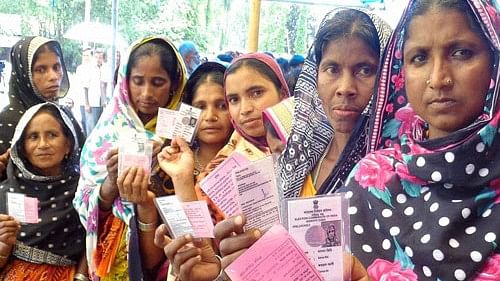
This file photo shows erstwhile Bangladeshi enclave dwellers showing their ink marked fingers and voter cards after casting votes for the first time at a polling station.
Credit: PTI Photo
Dinhata (Cooch Behar): They were nowhere-people for 67 years. But nine years after a historic India-Bangladesh land-swapping agreement gave them an identity, life hasn't progressed much for thousands of people living in the erstwhile enclaves as assurances made by politicians have vanished into thin air.
A big uncertainty hangs on their most prized asset - the land - as the administration is yet to hand over their proper land record documents and barely any initiative has been taken to carry out the field survey to finalize the records.
People living in these hamlets in Cooch Behar district in the northern part of West Bengal have received their identity documents like voter ID cards, ration cards and Aadhaar cards, but other promises to improve their lives didn’t materialise.
“We were told there will be new primary schools where some of us will get jobs as teachers. I acquired the qualifications, but no schools have been set up. We were told Anganwadi centres will be created, but none came up,” Nitu Roy Sarkar, a resident of Dakshin Mashaldanga village – a Bangladeshi enclave that became a part of India in 2015 - told DH.
As per the Land Boundary Agreement between two sides, 111 “Indian” enclaves (an area of 17,161 acres) went to Bangladesh whereas 51 “Bangladeshi” enclaves (7,110 acres) integrated with India.
The residents of these enclaves – a colonial legacy – were given a choice to pick up the country where they wish to live. As many as 15,856 people like Sarkar who had been living in India without being recognised as citizens, decided to stay and became legal citizens.
Also, 921 people from Bangladesh – some of the residents of Indian enclaves in Bangladesh – came back to India. They were initially housed in make-shift tin-roof camps but were shifted in 2020 to three apartment clusters at Dinhata, Haldibari and Mekhliganj blocks, made by the West Bengal government with financial support from the centre. Many of these apartments are overcrowded with over 20 people sharing a two-bedroom flat.
Dakshin Mashaldanga with 1300 voters was one of the “Bangladeshi” enclaves that has been become a part of India. Kachua is another one nearby. It is a part of Cooch Behar Lok Sabha constituency, which will go to the polls on April 19.
The villagers rely on farming and odd jobs like driving e-rickshaws for livelihood. Many have joined the gangs of migrant labourers that Cooch Behar district supplies to other parts of the country.
“Earlier in the absence of identity documents our friends had to face police harassment and even jails in other states. Thankfully that problem has gone. But economically we have not progressed much since 2015, but we get a ration of 21 kg of rice and 12 kg wheat flour (atta) every month,” said Basanti Barman, another inhabitant of the village.
Top politicians have forgotten these villages – about 50 km from Cooch Behar town – and the local ones appear mostly during election time, seeking votes.
In the last nine years, there has not been any effort to carry out a cadastral survey to create the proper land records for the enclave residents. In the absence of such documents, the villagers can’t send their land even at the time of a crisis. The villagers were given a draft document, which has little commercial value.
“This was possibly the world’s only example of exchange of land between two countries without any bloodshed. While the state took the credit, no respect was given to the people. Everything is stuck in the absence of the survey,” commented Diptiman Sengupta who has been associated with this land enclave exchange movement for decades.
